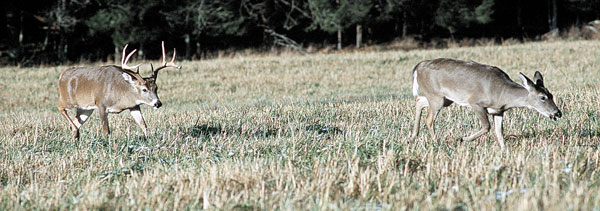
To take big bucks, these experts adapt their tactics to the breeding cycle.
The verdict isn’t unanimous, but among deer hunters, it’s generally agreed that your chances of harvesting a trophy buck are never better than when the peak of the breeding season or “rut” approaches.
Some hunters will argue that the first few days of archery season in September are a great time, because bucks are in a predictable summer pattern and their travels more easily mapped, but there’s no escaping that of the bucks that inhabit the top of the heap in North Carolina, most were killed during November — the acclaimed peak of the rut across the state.
Technically, the “peak” of the rut is the period lasting a handful of days when the greatest number of does are bred. According to the N.C. Wildlife Resources Commission, the peak of the rut can occur as early as the end of October in the extreme southeastern corner of the state, to around the first week of December in the extreme western mountains.
But bucks and does exhibit rutting behavior for weeks on either side of the “peak.” For a number of reasons, does enter their estrus period at different times, often several weeks apart in the same herd. Health and age are often credited with having the most effect on when a doe becomes receptive, and because does may come into estrus over a period of several weeks, bucks spend the month of November in various stages of “on the prowl.”
As the first does come into estrus, bucks start to put down more breeding sign in the form of scrapes, which they check regularly to see if an estrus doe has paid a visit — while staying in their core area. As the peak of the rut crawls over the horizon, the desire to breed far exceeds a buck’s need to stay in his safe, core area, and he starts to roam, looking to cross the path of as many does as possible, trying to find the one that’s ready on any certain day.
That change in behavior is what most deer hunters dream about. Being able to put those dreams into practice, knowing how to change your tactics, is what puts big racks on the walls of certain homes and hunt clubs.
“During the rut, bucks lose every bit of sense they have — just like I did when I was 16,” said Quinn Vaughn of Northeast Guide Service in Ahoskie (252-209-7455).
Ric Blake of Ric’s Hunting and Fishing Adventures in Reidville agrees.
“If a buck thinks there’s a doe in heat, he can be as dumb as a rock,” said Blake (336-342-4637). “He’ll be slobbering at the mouth.”
Hunters who figuratively keep their ear to the ground can pick up the kind of signs that will steer them to the right place and plan.
When the first does come into estrus, bucks will start to spend more time roaming, or cruising the woods, checking out does at a distance, trying to pick up the “right” scent. That point, in what is normally referred to as the “pre-rut,” is when a lot of sparring and fighting starts to take place as bucks really try to cement their spot atop the pecking order. Because only a few does are in estrus, there’s more competition among bucks to breed them, and that should put hunters in a certain mindset.
A week or 10 days before the true peak of breeding activity, even the most careful bucks will travel constantly, looking to check in on as many does as possible and breeding as much as he physically can. This is when bucks will start to cruise into strange areas, pushed out of their home turf by the “herd bulls,” and trying to poach on their neighbor’s harem. And you’ll be as likely to see a big buck roaming at 1 p.m. as you will at 7:30 a.m. or 5:15 p.m.
At the true peak of the rut, hunters often see fewer bucks, because bucks are almost constantly with does, instead of cruising the woods looking for them. After the peak of the rut, there are still a few does that haven’t been bred, and bucks slide back into sort of a pre-rut mode, checking scrapes and looking hard for female companionship — but tempered somewhat by the fact that many of their buddies have disappeared, leaving the woods in the back of pickup trucks, and by the scent of man in the woods.
And most of this takes place in from the middle of October through the middle of December, depending on where you’re hunting.
“I just make sure I’m in the woods, because you can’t kill a deer at work,” said Don Hartman of Weddington (704-289-1717), owner of the Central Carolina Hunt Club. “You need to spend every available moment you can hunting. You need to be in the woods in November. I think you have deer that breed from October all the way maybe into March, but the rut is strongest in November.”
Hartman, a QDMA-certified deer steward who leases more than 6,000 acres in nine different Piedmont counties for the members of his club, said he only makes a few, subtle changes in places he sets up stands as the rut approaches. One reason is, he doesn’t spend as much time in the early season hunting specifically for big bucks. He spends more time tracking the movement of does and finding the food source they’re exploiting the most. So when the rut approaches and bucks start showing up, looking for love, Hartman is — or has his hunters — already in an area where buck/doe rendezvous may be taking place.
“I don’t change (stand) locations all that much as the rut approaches,” he said. “I’ll put my stands in an area where I’m mainly overlooking a food source. If does are around, they’ll be around acorns from about the third week of October on when they start dropping. And if you’re around the does, you’ll be around bucks.”
Hartman said that natural food sources will almost always attract more deer than bait — whether it’s corn, sweet potatoes or apples — so he tries to concentrate on what’s in the woods and fields that deer like. He learned a tough lesson years ago.
“I was hunting in Union County, and I had corn out and a molasses block out. I put some corn on top of the molasses block, and it stayed on top of that block, untouched for more than a week, because there were acorns falling. The deer were ignoring everything else for the acorns. That was the last time I baited,” he said.
Blake who said the peak of the rut in his northern Piedmont home county of Rockingham roughly hits around the early-November blackpowder season, said he scouts for acorns before he starts looking for deer sign.
“If you can find one tree that’s producing a little more than the rest, that’s the tree to go to,” he said. “The does will come to that one tree, and if the does are gonna be there, he’s gonna be there.
“Oh, you’ll see the signs of where he’s been coming and going, his corridor, and you can try to find him there, but most of the time, you’re gonna find him around the does; so I concentrate on does. I killed a big buck last year; he weighed over 200 pounds, and he was on acorns. There were acorns on this one ridge, and the does were hitting them, and he was keeping that ridge hot. I actually passed up buck after buck, smaller bucks, before I shot him.”
Clay McPherson, who runs Cutawhiskie Creek Outfitters in Ahoskie, said deer in his neck of the woods in the extreme northeastern corner of the state have often had their fill of acorns as the rut approaches, because trees shed them earlier.
“Typically, our deer are eating acorns when they fall in September and October, but when you get close to the rut, they’re going back to whatever agricultural crop they can find,” said McPherson (252-333-2279). “This is when a food plot can really be good. I’ll use buck forage oats, chicory, alfalfa, winter peas, different types of sorghum, and even sunflowers.”
One other change that veteran hunters often make as the rut approaches is to abandon their typical early-morning, late-afternoon hunting schedule — which matches the feeding schedules of deer. When bucks’ blood starts to boil and they start actively roaming, looking for does, they’re liable to show up anytime.
“It’s not about food anymore,” Blake said. “When blackpowder season gets here (mid-October in northeast North Carolina), he’s not thinking about eating — there’s no real early and late feeding cycle. He’s checking his perimeter for does, and he’ll run all day.
“That’s when you’ve got to be there all day. The best time to kill him is in mid-day, if you can stay in your stand long enough, because he’s moving all the time, checking for his does.”
Toward the end of the rut, hunting pressure and a decreasing number of hot does may bring him back to his senses.
“He won’t go nocturnal until he’s had enough,” Blake said. “After muzzleloader season and after a week or two of gun season, he’ll start to think, ‘Hey, I need to quit showing up out here.’ The only reason he’s coming out during the day is because the does are driving him crazy.”

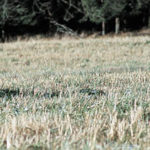
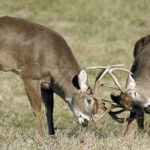
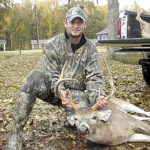
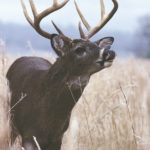



Be the first to comment